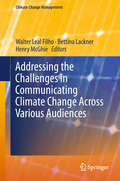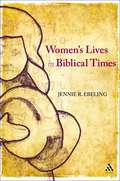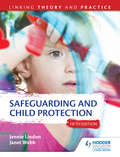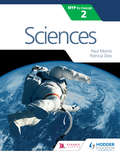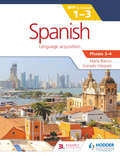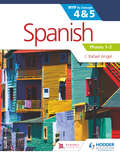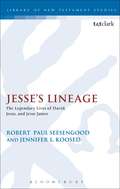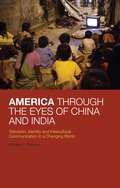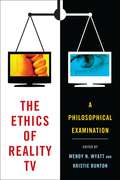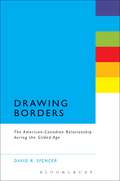- Table View
- List View
Addressing the Challenges in Communicating Climate Change Across Various Audiences (Climate Change Management)
by Henry McGhie Bettina Lackner Walter Leal FilhoThis book offers a concrete contribution towards a better understanding of climate change communication. It ultimately helps to catalyse the sort of cross-sectoral action needed to address the phenomenon of climate change and its many consequences. There is a perceived need to foster a better understanding of what climate change is, and to identify approaches, processes, methods and tools which may help to better communicate it. There is also a need for successful examples showing how communication can take place across society and stakeholders. Addressing the challenges in communicating to various audiences and providing a platform for reflections, it showcases lessons learnt from research, field projects and best practices in various settings in various different countries. The acquired knowledge can be adapted and applied to other situations.
Learning Primary Geography: Ideas and Inspiration from Classrooms
by Susan PikeLearning Primary Geography: Ideas and inspiration from classrooms celebrates children’s learning in primary geography. It is a book for all student and practising teachers who would like children to learn about their world in an enjoyable and stimulating way. Every page presents inspiring examples of children’s learning, and explains how and why creative approaches such as enquiry learning, learning outside the classroom and using imaginative resources work so well in primary geography. Using illustrated case studies from a range of schools and classrooms, each chapter showcases the fantastic work all children can do in primary geography. The book explores a wide variety of geographical learning, with chapters focusing on key aspects of the subject, including: • primary geography in the school grounds • topical geography through issues and events • learning about places in primary geography • children’s agency and action through primary geography. Throughout the chapters, the role of primary geography in helping children develop all types of literacies, including spatial, critical and digital literacies, is explored. Written by a highly experienced teacher and lecturer in education, Learning Primary Geography is underpinned and illustrated by examples from a wide range of primary classrooms. It will be a source of support, guidance and inspiration for all those teaching geography in the primary school.
Learning Primary Geography: Ideas and Inspiration from Classrooms (PDF)
by Susan PikeLearning Primary Geography: Ideas and inspiration from classrooms celebrates children’s learning in primary geography. It is a book for all student and practising teachers who would like children to learn about their world in an enjoyable and stimulating way. Every page presents inspiring examples of children’s learning, and explains how and why creative approaches such as enquiry learning, learning outside the classroom and using imaginative resources work so well in primary geography. Using illustrated case studies from a range of schools and classrooms, each chapter showcases the fantastic work all children can do in primary geography. The book explores a wide variety of geographical learning, with chapters focusing on key aspects of the subject, including: • primary geography in the school grounds • topical geography through issues and events • learning about places in primary geography • children’s agency and action through primary geography. Throughout the chapters, the role of primary geography in helping children develop all types of literacies, including spatial, critical and digital literacies, is explored. Written by a highly experienced teacher and lecturer in education, Learning Primary Geography is underpinned and illustrated by examples from a wide range of primary classrooms. It will be a source of support, guidance and inspiration for all those teaching geography in the primary school.
Teaching Geography Creatively
by Stephen ScoffhamTeaching Geography Creatively was Winner of the Geographical Association Gold Award 2014. This fully updated second edition of Teaching Geography Creatively is a stimulating source of guidance for busy trainee and experienced teachers. Packed full of practical approaches for bringing the teaching of geography to life, it offers a range of innovative ideas for exploring physical geography, human geography and environmental issues. Underpinned by the latest research and theory, expert authors from schools and universities explore the inter-relationship between creativity and learning, and consider how creativity can enhance pupils’ motivation, self-image and well-being. Two brand new chapters focus on creative approaches to learning about the physical world, as well as the value of alternative learning settings. Further imaginative ideas include: n games and starter activities as entry points for creative learning n how to keep geography messy n the outdoors and learning beyond the classroom n how to teach geography using your local area n the links between geography and other areas of the curriculum n looking at geography, creativity and the future n fun and games in geography n engaging with the world through picture-books n teaching about sustainability. With contemporary, cutting-edge practice at the forefront, Teaching Geography Creatively is an essential read for all trainee and practising teachers, offering a variety of practical strategies to create a fun and stimulating learning environment. In the process it offers a pedagogy that respects the integrity of children as joyful and imaginative learners and which offers a vision of how geography can contribute to constructing a better and more equitable world.
Teaching Geography Creatively (PDF)
by Stephen ScoffhamTeaching Geography Creatively was Winner of the Geographical Association Gold Award 2014. This fully updated second edition of Teaching Geography Creatively is a stimulating source of guidance for busy trainee and experienced teachers. Packed full of practical approaches for bringing the teaching of geography to life, it offers a range of innovative ideas for exploring physical geography, human geography and environmental issues. Underpinned by the latest research and theory, expert authors from schools and universities explore the inter-relationship between creativity and learning, and consider how creativity can enhance pupils’ motivation, self-image and well-being. Two brand new chapters focus on creative approaches to learning about the physical world, as well as the value of alternative learning settings. Further imaginative ideas include: n games and starter activities as entry points for creative learning n how to keep geography messy n the outdoors and learning beyond the classroom n how to teach geography using your local area n the links between geography and other areas of the curriculum n looking at geography, creativity and the future n fun and games in geography n engaging with the world through picture-books n teaching about sustainability. With contemporary, cutting-edge practice at the forefront, Teaching Geography Creatively is an essential read for all trainee and practising teachers, offering a variety of practical strategies to create a fun and stimulating learning environment. In the process it offers a pedagogy that respects the integrity of children as joyful and imaginative learners and which offers a vision of how geography can contribute to constructing a better and more equitable world.
The Tenants' Movement: Resident Involvement, Community Action and the Contentious Politics of Housing (Housing And Society Ser.)
by Quintin BradleyThe Tenants’ Movement is both a history of tenant organisation and mobilisation, and a guide to understanding how the struggles of tenant organisers have come to shape housing policy today. Charting the history of tenant mobilisation, and the rise of consumer movements in housing, it is one of the first cross-cultural, historical analyses of tenants’ organisations’ roles in housing policy. This book shows both the past and future of tenant mobilisation. The book’s approach applies social movement theory to housing studies, and bridges gaps between research in urban sociology, urban studies and the built environment. It provides a challenging study of the ability of contemporary social movements, community campaigns and urban struggles to shape the debate around public services and engage with the unfinished project of welfare reform.
The Tenants' Movement: Resident Involvement, Community Action and the Contentious Politics of Housing (PDF) (Housing And Society Ser.)
by Quintin BradleyThe Tenants’ Movement is both a history of tenant organisation and mobilisation, and a guide to understanding how the struggles of tenant organisers have come to shape housing policy today. Charting the history of tenant mobilisation, and the rise of consumer movements in housing, it is one of the first cross-cultural, historical analyses of tenants’ organisations’ roles in housing policy. This book shows both the past and future of tenant mobilisation. The book’s approach applies social movement theory to housing studies, and bridges gaps between research in urban sociology, urban studies and the built environment. It provides a challenging study of the ability of contemporary social movements, community campaigns and urban struggles to shape the debate around public services and engage with the unfinished project of welfare reform.
The Indian Rivers: Scientific and Socio-economic Aspects (Springer Hydrogeology)
by Dhruv Sen SinghThe book presents geomorphological studies of the major river basins – the Indus, Ganga and Brahmaputra and their tributaries. Besides major basins, the book explores peninsular rivers and other rivers state-by-state. All types of rivers, i.e. snow-fed, rain-fed and groundwater-fed rivers are explained together in geological framework. Rivers are lifeline and understanding of the rivers, their dynamics, science and socio-economic aspect is very important. However, different sources provide different data base for rivers. But a book which explains all major rivers of a country at a single place was not yet available. This book is the first book of its kind in the world which provides expert opinion on all major rivers of a country like India. This book complements works in these areas for the last two to three decades on major rivers of India by eminent professors and scientists from different universities, IITs and Indian research institutions. The information presented in the book would appeal to a wider readership from students, teachers to researchers and planners engaged in developmental work and also to common people of the society concerned with awareness about rivers.
Women's Lives in Biblical Times
by Jennie R. EbelingThis volume describes the lifecycle events and daily life activities experienced by girls and women in ancient Israel examining recent biblical scholarship and other textual evidence from the ancient Near East and Egypt including archaeological, iconographic and ethnographic data. From this Ebeling creates a detailed, accessible description of the lives of women living in the central highland villages of Iron Age I (ca. 1200-1000 BCE) Israel. The book opens with an introduction that provides a brief historical survey of Iron Age (ca. 1200-586 BCE) Israel, a discussion of the problems involved in using the Hebrew Bible as a source, a rationale for the project and a brief narrative of one woman's life in ancient Israel to put the events described in the book into context. It continues with seven thematic chapters that chronicle her life, focusing on the specific events, customs, crafts, technologies and other activities in which an Israelite female would have participated on a daily basis.
Safeguarding and Child Protection (5th Edition) (PDF)
by Jennie Lindon Janet WebbEnsure your students link theory with practice with this updated version of the authoritative and accessible series from Jennie LindonLinking Theory and Practice has helped thousands of students make the right connections between their lectures and the real settings that they go on to work in. This latest edition of Safeguarding and Child Protection provides a useful overview of the subject in straightforward language that allows novices to access the more complicated concepts. Jennie Lindon's trademark approach provides a trusted and authoritative voice for a wide range of courses, including undergraduate and foundation degrees in Early Years and Early Childhood, PGCEs and BEd programmes.· Includes detailed references for further reading with descriptions of 'key texts' for each chapter· 'Pause for reflection' feature provides numerous opportunities to think about the impact of their own role.- Provides an essential practical toolkit for anyone who works with children.
Sciences for the IB MYP 2 (PDF)
by Paul Morris Patricia DeoA concept-driven and assessment-focused approach to Sciences teaching and learning.- Approaches each chapter with statements of inquiry framed by key and related concepts, set in a global context- Supports every aspect of assessment using tasks designed by an experienced MYP educator- Differentiates and extends learning with research projects and interdisciplinary opportunities- Applies global contexts in meaningful ways to offer an MYP Sciences programme with an internationally-minded perspectiveContents list1 Where are we now and where are we going? 2 How do we map matter?3 Who are we? 4 How can we find out? 5 How does our planet work?6 How do we respond to our world?
Cognitive Perspectives on Israelite Identity (The Library of Hebrew Bible/Old Testament Studies)
by Dermot Anthony NestorCognitive Perspectives on Israelite Identity breaks new ground in the study of ethnic identity in the ancient world through the articulation of an explicitly cognitive perspective. In presenting a view of ethnicity as an epistemological rather than an ontological entity, this work seeks to correct the pronounced tendency towards 'analytical groupism' in the academic literature. Challenging what Pierre Bourdieu has called 'our primary inclination to think the world in a substantialist manner,' this study seeks to break with the vernacular categories and 'commonsense primordialisms' encoded within the Biblical texts, whilst at the same time accounting for their tenacious hold on our social and political imagination. It is the recognition of the performative and reifying potential of these categories of ethno-political practice that disqualifies their appropriation as categories of social analysis.
Spanish for the IB MYP 1-3 Phases 3-4 (PDF)
by María Blanco Gonzalo VázquezA concept-driven and assessment-focused approach to Spanish teaching and learning.- Approaches each chapter with statements of inquiry framed by key and related concepts, set in a global context- Supports every aspect of assessment using tasks designed by an experienced MYP educator- Differentiates and extends learning with research projects and interdisciplinary opportunities- Applies global contexts in meaningful ways to offer an MYP Spanish programme with an internationally-minded perspective
Spanish for the IB MYP 4&5 Phases 1-2 (PDF)
by J. Rafael AngelEndorsed by the IBDrive meaningful inquiry through a unique concept-driven narrative.- Supports every aspect of assessment with opportunities that use the criteria- Gives you easy ways to differentiate and extend learning- Provides a meaningful approach by integrating the inquiry statement in a global context- Develops critical-thinking skills with activities and summative sections rooted in the ATL framework
Jesse's Lineage: The Legendary Lives of David, Jesus, and Jesse James (The Library of Hebrew Bible/Old Testament Studies)
by Robert Seesengood Jennifer L. KoosedJesse's Lineage explores the interconnections between David, Jesus, and Jesse James. All three of these figures evoked complicated and conflicted reactions from their contemporaries - considered criminals by some, saviors by others. David lives the life of a bandit while on the run from Saul; Jesus dies the death of a bandit alongside other bandits; Jesse James is the paragon of the bandit in the American West and yet his life and death is also understood in biblical terms. Iron Age Judah, Roman Galilee, and Reconstruction era Missouri alike invoke the context of colonial "territories" and areas of resistance. Such contexts give birth to bandits, the heroes of the subaltern. After their deaths, David, Jesus, and Jesse James live on thorough equally complicated and conflicted textual, ritual, and cultural memories. Their stories intertwine through reference and allusion as Jesus' mission is understood in terms of David's promise, and Jesse's death is understood in terms of Jesus' betrayal. The biography of each figure is further complicated by the processes of folk memory and oral transmission.
America Through the Eyes of China and India: Television, Identity, and Intercultural Communication in a Changing World
by Edward D. ShermanAmerica has long exported its network and cable programming abroad, but with a changing world comes a changing dynamic. As global centers of power shift, and wealth becomes redistributed, and perhaps even re-centered, vast audiences which have never before had contact with American television will begin to gain access to the full wealth and abundance of American programming. The opening of new markets and new audiences, particularly within the growing superpowers of China and India, presents us with a novel situation. It is one thing for a show like The OC to be played in a nation like England, where the cultural and religious differences with the United States are not that profound, and quite another for it to air in a nation like India, where arranged marriages, the caste system, and pervasive poverty are still everyday realities.America Through the Eyes of China and India explores the dynamics of television, identity, and cultural communication, providing a new lens for encountering, interpreting, and judging American culture and the American identity.
The Ethics of Reality TV: A Philosophical Examination
by Wendy N. Wyatt Kristie BuntonReality television is continuing to grow, both in numbers and in popularity. The scholarship on reality TV is beginning to catch up, but one of the most enduring questions about the genre-Is it ethical?-has yet to be addressed in any systematic and comprehensive way. Through investigating issues ranging from deception and privacy breaches to community building and democratization of TV, The Ethics of Reality TV explores the ways in which reality TV may create both benefits and harms to society. The edited collection features the work of leading scholars in the field of media ethics and provides a comprehensive assessment of the ethical effects of the genre.
The History of the Provincial Press in England
by Rachel MatthewsRegional newspapers around the globe are fighting to survive in the face of challenges to their economic model, due to the constant influx of new technology. At the same time, while studies of the national press have created a continuous narrative on the newspaper, the history of the regional press has been subject to relatively little academic scrutiny, despite being a significant industry in terms of a readership, circulation and profit. By focusing on provincial English newspapers, Matthews makes the case for the larger issue of the future of local newspapers worldwide. She argues that a comprehensive approach to the history of the regional press can result in a conceptualization of the industry in terms of the shift in emphasis between the key elements of state control, ownership, social influence and production techniques. They can be categorized into six distinct stages: the local newspaper as opportunistic creation; the characterization of the local newspaper as fourth estate; the impact of New Journalism; the growth of chain control, the shock of the free paper and new technology and finally, the current picture, the search for a new business model.
The Ethics of Emerging Media: Information, Social Norms, and New Media Technology
by Kathleen German Bruce E. DrushelThe Ethics of Emerging Media engages with enduring ethical questions while addressing critical questions concerning ethical boundaries at the forefront of new media development. This collection provides a rare opportunity to ask how emerging media affect the ethical choices in our lives and the lives of people across the globe. Centering on different new media forms from eBay to Wikipedia, each chapter raises questions about how changing media formats affect current theoretical understanding of ethics. By interrogating traditional ethical theory, we can better understand the challenges to ethical decision making in an age of rapidly evolving media. Each chapter focuses on a specific case within the broader conceptual fabric of ethical theory. The case studies ground the discussion of ethics in practical applications while, at the same time, addressing moral dilemmas that have plagued us for generations. The specific applications will undoubtedly continue to unfold, but the ethical questions will endure.
Conscience and Calling: Ethical Reflections on Catholic Women's Church Vocations
by Anne E. PatrickThis volume probes the meaning and ethical implications of the powerful symbol of vocation from the vantage of contemporary Catholic women, with particular attention to the experiences of women religious. Intended as a follow-up to Liberating Conscience: Feminist Explorations in Catholic Moral Theology, the new book will benefit many readers, including Catholic leaders, laity, and religious, as well as persons interested in Christian ethics and American religious history more generally. The work treats twentieth-century history and more recent developments, including tensions between the Vatican and progressive Catholics, the development of lay ministries, and the movement to ordain women deacons, priests, and bishops.
News Media in the Arab World: A Study of 10 Arab and Muslim Countries
by Barrie Gunter Roger DickinsonNews Media in the Arab World: A Study of 10 Arab and Muslim Countries is based on ongoing research at the Department of Media and Communication, University of Leicester, and has investigated the rapidly changing nature of the news media in Arab countries. They have investigated the role of newspapers and television in news provision and the impact of new media developments, most especially the emergence of the internet as a platform for news distribution and of international satellite television channels such as Al Jazeera. Examining the constantly developing nature of news, the collection contains separately authored chapters produced by the researchers responsible for each original analysis, covering Bahrain, Egypt, Iraq, Kuwait, Libya, Oman, Qatar, Palestine, Saudi Arabia and the United Arab Emirates. Based on original primary and secondary research, this will be the first empirical-based collection to blend perspectives from both the Western and Arab nations.
The Past is the Present; It's the Future Too: The Temporal Turn in Contemporary Art
by Christine RossThe term 'temporality' often refers to the traditional mode of the way time is: a linear procession of past, present and future. As philosophers will note, this is not always the case. Christine Ross builds on current philosophical and theoretical examinations of time and applies them to the field of contemporary art: films, video installations, sculpture and performance works. Ross first provides an interdisciplinary overview of contemporary studies on time, focusing on findings in philosophy, psychology, sociology, communications, history, postcolonial studies, and ecology. She then illustrates how contemporary artistic practices play around with what we consider linear time. Engaging the work of artists such as Guido van der Werve, Melik Ohanian, Harun Farocki, and Stan Douglas, allows investigation though the art, as opposed to having art taking an ancillary role. The Past is the Present; It's the Future Too forces the reader to understand the complexities of the significance of temporal development in new artistic practices.
McLuhan: A Guide for the Perplexed (Guides for the Perplexed)
by W. Terrence GordonMarshall McLuhan was dubbed a media guru when he came to prominence in the 1960s. The Woodstock generation found him cool; their parents found him perplexing. By 1963, McLuhan was Director of the Centre for Culture and Technology at the University of Toronto and would be a public intellectual on the international stage for more than a decade, then linked forever to his two best known coinages: the global village and the medium is the message. Taken as a whole, McLuhan's writings reveal a profound coherence and illuminate his unifying vision for the study of language, literature, and culture, grounded in the broad understanding of any medium or technology as an extension of the human body. McLuhan: A Guide for the Perplexed is a close reading of all of his work with a focus on tracing the systematic development of his thought. The overriding objective is to clarify all of McLuhan's thinking, to consolidate it in a fashion which prevents misreading, and to open the way to advancing his own program: ensuring that the world does not sleepwalk into the twenty-first century with nineteenth-century perceptions.
Drawing Borders: The American-Canadian Relationship during the Gilded Age
by David R. SpencerCanada has not always had the role of 'friendly neighbor to the north.' In fact, the seemingly peaceful history of relations between the United States and Canada is punctuated with instances of border disputes, annexation manifestos and trade disagreements. David R. Spencer reveals the complexity of this relationship through a fascinating examination of political cartoons that appeared both in the U.S. and Canada from 1849 through the 1990s. By first examining both the cultural and political differences and similarities between the two nations, Spencer lays the groundwork for the main focus of his study - deeper analysis of the political perspectives of the editorial cartoons. Including 141 actual cartoons of the time, Spencer provides meaningful references to the historical material covered. An intriguing study by a leading Canadian-American scholar, this work is sure to interest many across the disciplines of journalism history, cartoons, media studies, communication and international relations.
Popular Ghosts: The Haunted Spaces of Everyday Culture
by Esther Peeren Maria del Pilar BlancoHaunting has long been a compelling element in popular culture, and has become an influential category in academic engagements with politics, economics, and aesthetics. While recent scholarship has used psychoanalysis and the Gothic as frameworks with which to study haunting, this volume seeks to situate ghosts in the cultural imagination. The chapters in Popular Ghosts are united by the impulse to theorize the cultural work that ghosts do within the trans-historical contexts that comprise our understanding of everyday life. These authors study the theoretical and aesthetic genealogies of the spectral, while also commenting on the multiple everyday spaces that this category occupies. Rather than looking to a single tradition or medium, the essays in Popular Ghosts explore film, novels, photography, television, music, social practices, and political structures from different cultures to reopen the questions that surround our haunted sense of the everyday.
